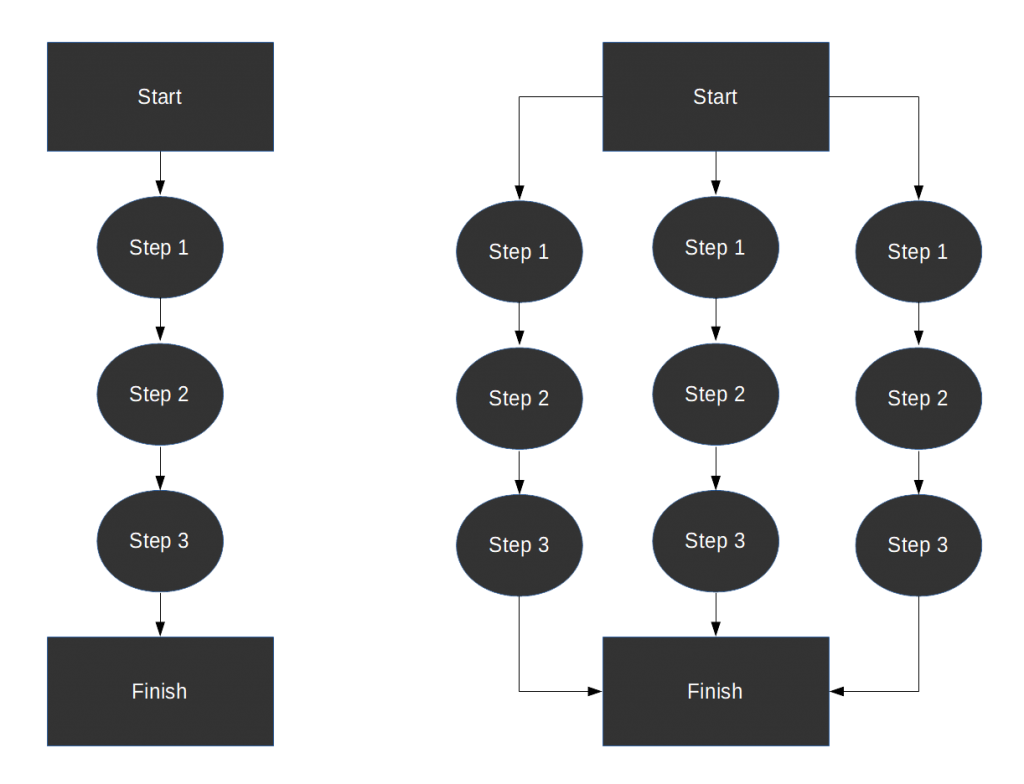

Mapping in parallel computing is used to solve embarrassingly parallel problems by applying a simple operation to all elements of a sequence without requiring communication between the subtasks.The popularization and evolution of parallel computing in the 21st century came in response to processor frequency scaling hitting the power wall. Superword-level parallelism: a vectorization technique that can exploit parallelism of inline codeParallel applications are typically classified as either fine-grained parallelism, in which subtasks will communicate several times per second coarse-grained parallelism, in which subtasks do not communicate several times per second or embarrassing parallelism, in which subtasks rarely or never communicate. Task parallelism: a form of parallelization of computer code across multiple processors that runs several different tasks at the same time on the same data Instruction-level parallelism: the hardware approach works upon dynamic parallelism, in which the processor decides at run-time which instructions to execute in parallel the software approach works upon static parallelism, in which the compiler decides which instructions to execute in parallel Bit-level parallelism: increases processor word size, which reduces the quantity of instructions the processor must execute in order to perform an operation on variables greater than the length of the word. Performance Limits with Parallel Computing.Parallel computing infrastructure is typically housed within a single datacenter where several processors are installed in a server rack computation requests are distributed in small chunks by the application server that are then executed simultaneously on each server.There are generally four types of parallel computing, available from both proprietary and open source parallel computing vendors - bit-level parallelism, instruction-level parallelism, task parallelism, or superword-level parallelism:

What Is Parallel Processing Full Access To
Each processor has a private cache memory, may be connected using on-chip mesh networks, and can work on any task no matter where the data for that task is located in memory. Symmetric multiprocessing: multiprocessor computer hardware and software architecture in which two or more independent, homogeneous processors are controlled by a single operating system instance that treats all processors equally, and is connected to a single, shared main memory with full access to all common resources and devices. Multi-core architectures are categorized as either homogeneous, which includes only identical cores, or heterogeneous, which includes cores that are not identical. Cores are integrated onto multiple dies in a single chip package or onto a single integrated circuit die, and may implement architectures such as multithreading, superscalar, vector, or VLIW.
Massively parallel computing: refers to the use of numerous computers or computer processors to simultaneously execute a set of computations in parallel. There is much overlap in distributed and parallel computing and the terms are sometimes used interchangeably. Distributed programming is typically categorized as client–server, three-tier, n-tier, or peer-to-peer architectures. Significant characteristics of distributed systems include independent failure of components and concurrency of components.
Some parallel computing software solutions and techniques include: Main memory in any parallel computer structure is either distributed memory or shared memory. Parallel Computing Software Solutions and TechniquesConcurrent programming languages, APIs, libraries, and parallel programming models have been developed to facilitate parallel computing on parallel hardware. Another approach is grid computing, in which many widely distributed computers work together and communicate via the Internet to solve a particular problem.Other parallel computer architectures include specialized parallel computers, cluster computing, grid computing, vector processors, application-specific integrated circuits, general-purpose computing on graphics processing units ( GPGPU), and reconfigurable computing with field-programmable gate arrays.
Automatic parallelization techniques include Parse, Analyze, Schedule, and Code Generation. Automatic parallelization: refers to the conversion of sequential code into multi-threaded code in order to use multiple processors simultaneously in a shared-memory multiprocessor (SMP) machine. Checkpointing is a crucial technique for highly parallel computing systems in which high performance computing is run across a large number of processors.
...
Where uni-processor machines use sequential data structures, data structures for parallel computing environments are concurrent. Software has traditionally been programmed sequentially, which provides a simpler approach, but is significantly limited by the speed of the processor and its ability to execute each series of instructions.


 0 kommentar(er)
0 kommentar(er)
